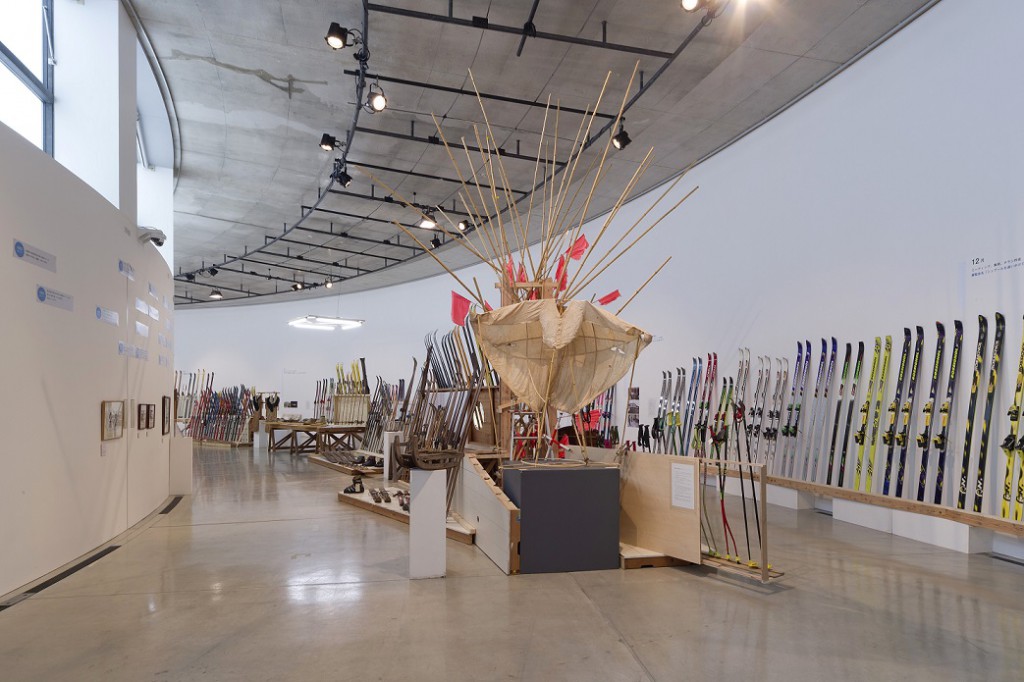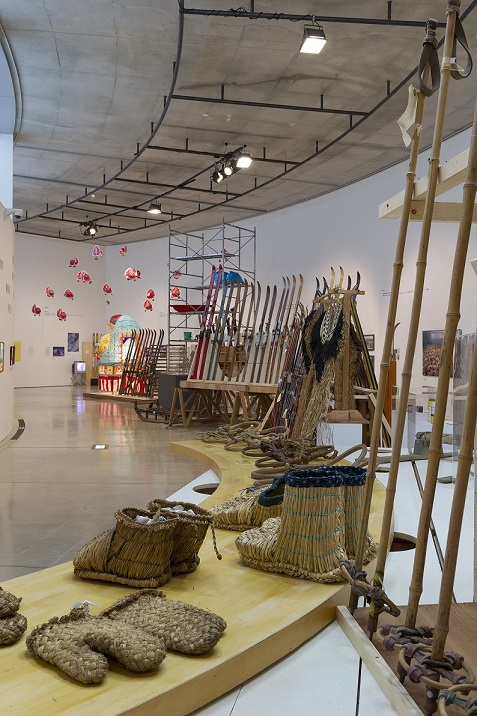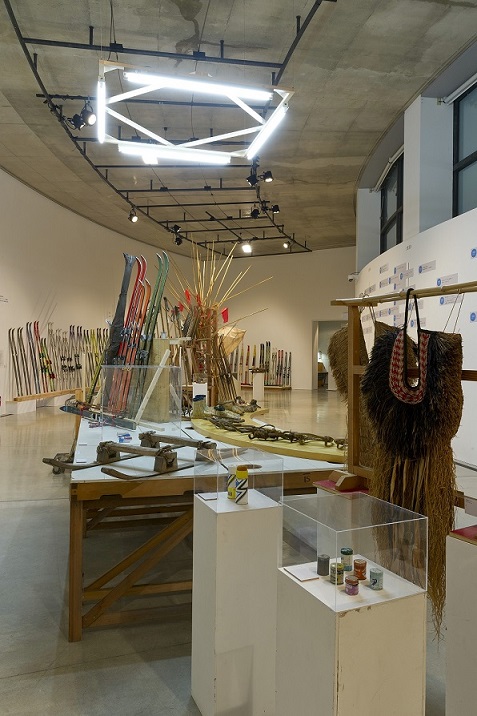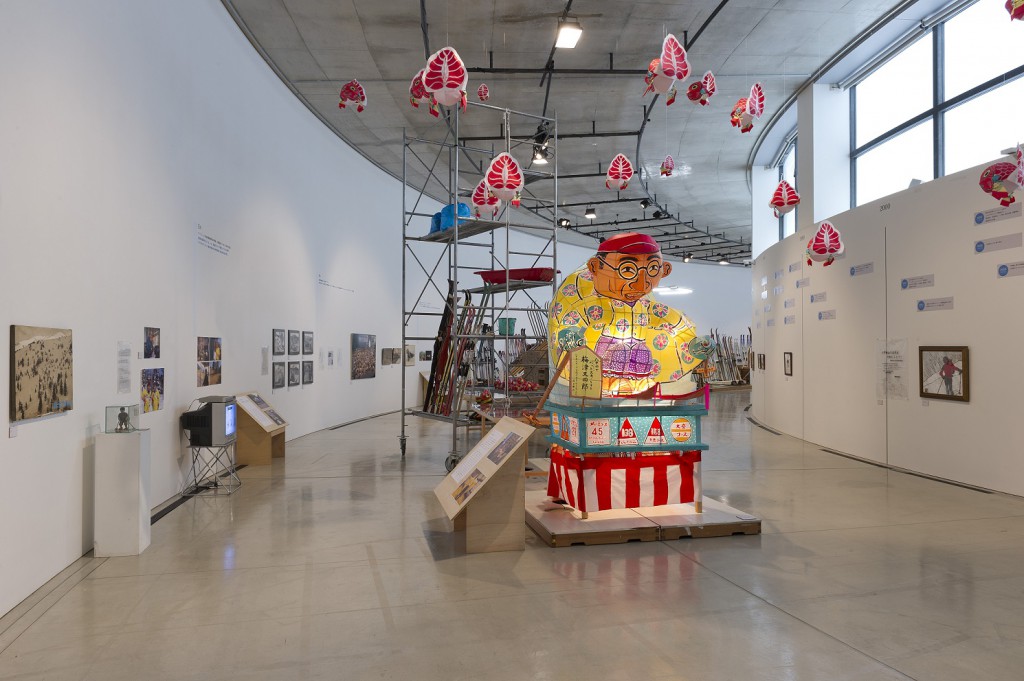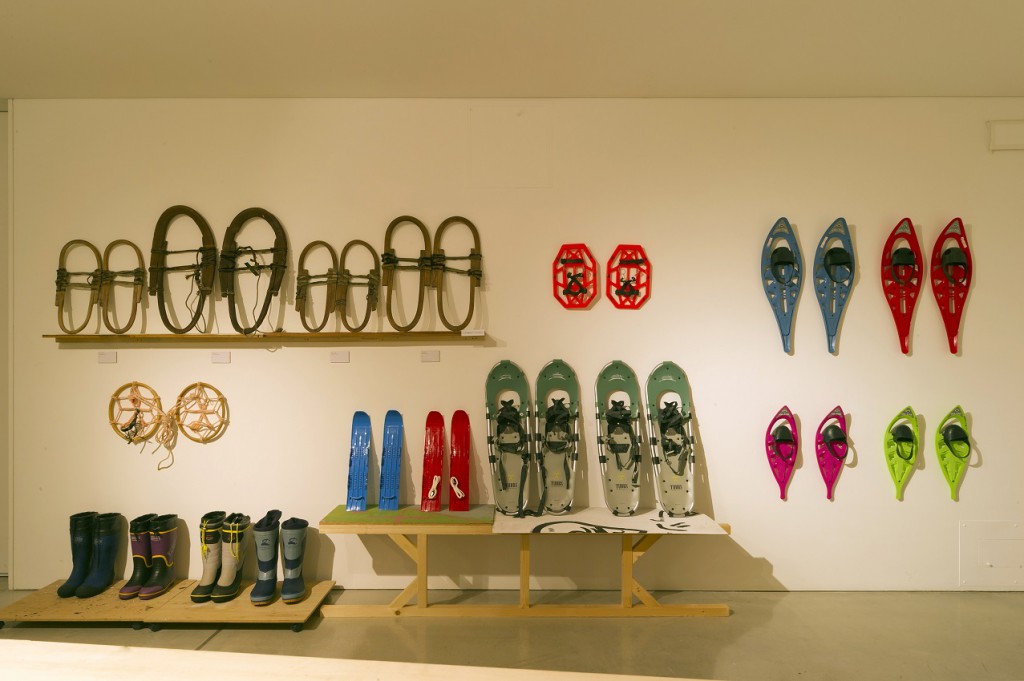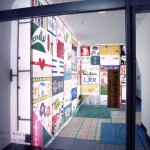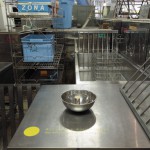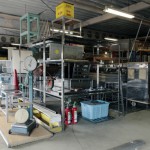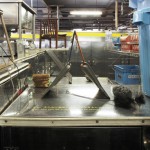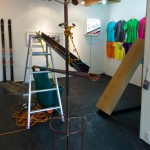
中崎透×青森市所蔵作品展
シュプールを追いかけて
青森市は日本有数の豪雪地として知られ、人々は厳しい冬を過ごすための独自の知恵と工夫を身に付けてきました。また、日本に近代スキーが取り入れられた当初からレジャーだけではなく、生活・仕事道具としてもスキーを活用し、そのような土壌から数多くのスキー選手が輩出してきました。
青森公立大学国際芸術センター青森(ACAC)では「青森市所蔵作品展をつくる」長期ワークショップとして、美術家の中崎透を監修に迎え1年かけて参加者と共に展覧会の準備を行ってきました。本展では、青森市の所蔵品だけではなく市内外の企業、団体、個人から借り受けた、三浦雄一郎を始めとする青森出身のスキーヤーが使った道具や、八甲田山に縁のある人物の写真・映像、青森の雪の風景を描いた版画や絵画、そして大正初期から最近ものまで100組以上のスキーなどを展示します。中崎とワークショップ参加者が青森の人、土地、歴史を追いかけてたどり着いた、雪にまつわるもう1つの青森の物語をお楽しみください。
展覧会ができるまでのワークショップの様子はこちらからご覧になれます。
>>「展覧会、つくらない!?」特設サイト
———-
こんにちは、中崎です。ここACACで一年を通したワークショップで展覧会を作りませんか、と誘われ、最初にリサーチに来たのは2013年の三月。早速訪れた市内の森林博物館で観たスキー道具が印象的で、「雪にまつわる道具」、みたいなぼんやりとしたテーマを決めました。僕も含め、展覧会作りの素人たちが右往左往しながら、いろんな人に出会い、転がってくように形づくられていった今回の展覧会。もろもろ専門家の方々の目から見たら欠けてるものがたくさんあるかもしれませんが、手探りで模索した僕たちのドタバタとした足跡を、そして青森という土地でやっかいな雪と向き合いそれを乗り越え共存してきた人間の工夫や遊び心の軌跡のようなものを、雪景色に刻まれたシュプールを辿るかのように体験していただければ幸いです。
中崎透(美術家)
—
展示風景
撮影:西川幸冶
—
【解説】
現在進行形を生きる
金子由紀子
「実は書かれた言葉というのは、すべて過去形なんですね。逆に声に出される言葉は過去のことを話していても現在形。つまり、その時に意識しているものはすべて現在だし、エモーションはすべて現在形でしかあり得ない。(中略)自分が経験したことは常に、現在に帰ってくる可能性がある」 管啓次郎[i]
冬の青森市では全てのものが雪に覆われる。雪片付け(除雪)をしなければ朝家を出ることさえままならないし、道幅は半分に狭まり、公共交通機関は遅れ、足元は長靴しか用を成さず、夕方は4時には薄暗くなり、吹雪に遭い前にも後ろにも進めないこともある。
こうして挙げてみるだけで、なぜこんなにも寒くつらい季節が1年の3分の1も占めるような土地に人間が住み始めることになったのか、ということにすら疑問を覚える。しかし、出来るだけ寒さをしのぎ、雪の中を自由に動いて、少しでも快適な冬を過ごすためのこの地方独特の知恵と工夫と共に、人々は暮らしを続けてきた。
2013年5月に始まった「展覧会、つくらない!?」ワークショップに参加したのは、年齢も職業もバラバラの人達、約20名である。その中にはACACに初めて来るという参加者もおり、活動はACACを知ることから始められた。その後参加者は中崎と共に、施設見学やトークイベントの開催、展示品の調査などを行ってきた。
中崎単独でも3月のリサーチの段階から、青森のスキー関係者を訪ねて話を聞くということを行ってきたが、ワークショップが本格化した7月以降も本誌や展覧会で取り上げることのできなかったものも含めて、インタビューの機会を意識的に作っていった。これは展覧会準備のごく基本的な調査の一環として、参考情報を得るために始められたため、当初は中崎も、ましてや参加者も直接その言葉を展示することは考えてはいなかった。しかし最終的には、中崎によってインタビューから抜粋した各人の言葉とものが結び付けられ、展覧会の重要な要素を構成することとなった。
インタビューでは過去の出来事や、オリンピックや山岳ガイドなどの特殊な現場を知る目的で行われたものの、それ以上に、話者と物・人・出来事との関係、話者の人柄、臨場感などが、書物を読むことでは得られない生々しさで、しかも魅力的な体験として迫ってきた。本や映像といったメディアを通して知っていた三浦雄一郎や棟方志功などの人物や、麓から眺めるだけだった八甲田について、今目の前にいる、しかも同じ土地で暮らしている個人が語っているということによって、語られる内容が自分達とは別の世界のおとぎ話ではなく、自分が今いる所と地続きの場所で起こった/起こっている、他人事ではなく自分事として捉えられる世界となった。
木村敏は現実をリアリティとアクチュアリティの2種類に区別し、リアリティを客観的・三人称的で常に現在から一瞬遅れた現在完了形で成立するとし、アクチュアリティを一人称的・現在進行形で変化する「活動の現場」とした。そして、合理的科学はリアリティを使命とする、としている。[ii]
本来合理的科学に基づき、リアリティが重視されがちな民俗資料を展示する展覧会において中崎は、インタビューの抜粋を展示品の解説文として展示に加えることによって、それが客観的現実かどうかという厳密さではなく、一人称で装飾された現実(アクチュアリティ)であっても、だからこそ、かえってその装飾から、特定の個人が人や物や出来事とどのような関係を結んできたかが見て取れることが重要である、ということを示してみせた。それこそは芸術の領域であり、人々が自分だけの視点で世界を見、関係を結ぶことを勇気づけ、それによって象られる、いびつではあっても誰もが持つ個人の物語を肯定する。
本プロジェクトは、アーティスト・イン・レジデンス型の教育普及プログラムとして企画された。平和学においては学びの方法としてエクスポージャー(物事が起こっている現場に実際に身を置くこと)[iii]というものがあるが、この1年間数々の現場に立ち会ってきたことは、この土地で起こってきたことと、そこで生きる人々がいるという現実を知ることで、目には見えないそれらとの関係の中に今の自分がいるという実感につながりはしないだろうか。現代アートを専門とするレジデンス施設であるACACが提案出来る学びの一つは、今まさに何かが起こっている現場を提供することによって、流動的な今、ここがあり、そこに生きている自分がいる、という実感を生み出すこと、そして死ぬまで続く「今」をどうにか生き抜く技と術を身に着けるきっかけをつくることはないだろうか。それは、現場に立つことでリアリティを一度疑ってみて、個人のアクチュアリティを信じること、つまり、自分の目で見て自分の頭で考えることを後押しすることではないか。
青森に生まれ育った人であっても、たまたま就職先や進学先が青森だった人であっても、縁あってそこに居る人々が、現在、自分が住むこの土地をどのように知っていくことが出来るのか。毎日の生活の中でどんな楽しみや喜びを見つけ、日々を慈しみながら生活していけるのか。毎朝の雪片付けに不平を言う代わりに、一歩だけ自分の日常から抜け出てみると、青森の環境の中で鍛えられた身体を武器にウインタースポーツの世界へ打って出る人がおり、山やスキーに惚れ込み仕事とし、超人的とも言える知識や技能を持つ人がおり、様々なエピソードを携えた八甲田という山がある。この1年間の人や物語との出会いは、やっかいものの雪という存在を、魅力的な物語を生みだす媒体として変化させた。現場に身を置き、生身の人間と出会い、たくさんのアクチュアリティを収集・生成したことが、自分が存在する「今、ここ」の輪郭を浮かび上がらせ、自分があらゆる世界と接続しうる可能性を持っているという自信となる。そしてそれがそのまま、生きていくことへの自信につながっていくことを夢想している。
[i] 高山明×管啓次郎「東京ヘトロトピアへの旅-ズレの翻訳論、過去から帰ってくる現在-」『東京ヘテロトピア』フェスティバル/トーキョー実行委員会事務局、2013年、4頁。
[ii] 木村敏『関係としての自己』、みすず書房、2005年、56-57頁。ただし「リアリティはかならずアクチュアリティ成分を含んでおり、アクチュアリティはリアリティを基盤にしてしか成立しない。」(同57頁)。
[iii] 「エクスポージャーとは文字通りの意味で、露出、すなわち身体を風にあて、光にさらすことである。(中略)ここでは、身も心も丸ごと別の地の人びとの生の状況に触れるような旅の仕方をいう。」(横山正樹「第三世界と先進工業諸国にわたる市民連帯は可能か」、『市民連帯論としての第三世界』、久保田順編著、文眞堂、1993年、47頁)。
—
遊びとあそび~市蔵作品展と中崎透の作品について
近藤由紀
中崎透の作品は、外的要因との関係性やその関与が作品を成立させるいわゆる「関係性の美学」[1]に依拠しており、他者の参加を必要とする。参加型の作品はコミュニケーションについて言及しながらも、しばしば対話におけるすれ違いが絶妙に仕立てられている。例えば中崎の初期作品である《看板屋なかざき》(fig.1)の最終的かつ物理的な形態としての看板作品は、他者からの依頼を受けて初めて制作される。だがそこではミス・コミュニケーションを前提としたコミュニケーションについての仮の「契約書」が交わされ、メッセージを発する側と受け取る側の間の解釈のずれを意図的に作り出している。中崎の作品が鑑賞者や協働者を取り込みながらも、どこか温度の低さを保っているようにみえるのは、対話のひずみに対する着目のみならず、中崎がそれらを現象としてではなく構造として捉えようとしていることにも拠るだろう。
「看板の受注生産」のように、中崎の作品においてしばしば仮の設定や目的が前提として提示される。それをロールプレイし、到達に至る過程や派生する出来事を疑似的に示すことで、氷山を転覆させるように芸術あるいは社会の下部構造を露わにする。それは中崎がユニットとして活動しているナデガタ・インスタント・パーティーのプロジェクトでもみられ、現実の行為や現象を模倣し、疑似体験を通じて再現する手法は演劇的である。ナデガタの場合ロールプレイはプロジェクトの過程において行われ、記録メディアによって仮構性を定着させていくナデガタの「展覧会」では、作品は記録映像や映画をみるように方向性をもった過去の時間軸において追体験される。一方中崎透の作品では作品は舞台のように鑑賞者と同じ時間軸で体験される。この体験的な作品鑑賞のためにしばしば用いられるのはテキストであり、場のコンテクストである。《十万年後の誰かが、プレイボーイを注意深く観察したとせよ。》(2011年)(fig.2)や《現代の習慣〜How We Behave Ourselves Today〜》(2013年)(fig.3)では、異なるコンテクストで提示された日用品やセンテンスを組み換えられた週刊誌から抜き出された任意のテキストが、舞台装置のように象徴的な意味を与えられた(ようにみえる)場と組み合わせられている。そこでは鑑賞者は作者の意図に方向づけられながらも、宙づりにされた行間を複数のストーリーの背景となることが可能なくらいニュートラルに開かれた舞台装置としてのインスタレーションの中で身体的、感覚的、能動的に体験することで、個人的かつ直接的に受容する。
今回仮に設定されたのは「市蔵作品展を作る」ということであろう。もちろんこれは前提条件でもあるのだが、当然のことながら中崎は、民俗学や歴史の専門家ではない。一方で中崎は「専門的な手法」を偽装しつつ、専門家でないことに自覚的かつ逆手にとって作業を進める。真摯に取り組む「専門家ではない」企画者たちは、最後の最後に曖昧さを自らに許し、意図的に史実の断定や確証から距離をとる。関係者からのインタビューを中心に構成された展示は、歴史的な事実関係の確かさよりも、インタビューを受けた個人の記憶や認識が重視されている。その人が話している空気感ごと伝わるように、文体を整えることも、津軽弁を標準語に統一することもせず、ほぼそのまま提示されているインタビューは、正確な伝達のために精査された情報とは逆に多くのノイズが入ったままの状態で示されている。一方でこの不確定さが情報の一方向的な送受信を回避し、気楽な介入の隙を与えている。寄せ集められた個人の記憶から発せられた主観的な語りとその舞台背景のような展示品は、無数のカンバセーションピースとして、それに接した人々の思い出や記憶、一家言を引き出し、「市蔵作品展」のワークショップも、その展覧会も、多くの人々が接続しうる対話の場として生成されている。
そう捉えるとこの展示は、青森の雪にまつわる道具の文化史を通覧したり、その埋もれた歴史を掘り起こしたりすることだけではなく、多くの曖昧な記憶や物語をそのまま含むことにより、いくつもの時代の断片を並置させ、それらがそこここで囁き続けることにまかせることで、主観的な記憶の総体としての歴史に向かっている。そこには歴史の客観性に対する作家の懐疑と同時に、青森という地方都市の歴史の遺物としての市蔵品に対する愛情を感じさせる。
この人々の記憶や意識の方向性を無理にまとめたりしないその姿勢は、中崎がしばしば作品によって突き付ける宙づりにされたコミュニケーション、「分かりあえなさ」の構造とも関係している。《パラレル/だからとかこそだとか》(2011年)(fig.4)は震災後ということもあったが、地域ごとに異なる震災のリアリティの違いとその「分かりあえなさ」を交差することのない平行線=パラレルという言葉で捉え、作品を構成している。それは「個」の感覚の重視とともに、もはや大きな一つの流れには乗ることのできない我々の時代の現実を表している。こうした構造は今回の市蔵作品展にも内在している。それゆえに今回の展示は単なる資料展であることを超えて、中崎透の作品としても成立しえたといえるのではないだろうか。
fig1 《看板屋なかざき》青森元フジ食堂での展示、2008年
fig2 《100000年後の誰かが、プレイボーイを注意深く観察したとせよ。》「引込線」での展示、2011年
fig3 《現代の習慣~How We Behave Ourselves Today~》遊戯室での展示、2013年
fig4 《パラレル/だからとかこそだとか》Art Center Ongoing、2011年
—
いくつものパラレルな世界をそのままかたちにする
服部浩之
中崎透は、複数の異なったレイヤーの出来事や物語をひとつの作品に投入することで、少しズレた地点から間接的に意思を述べることを常套手段とするため、その真意が簡単には読み取りにくいアーティストのひとりだ。しかし本展覧会では、前提条件として既にいくつものズラしや並行する物語が挿入されていたため、逆に中崎の意思を明確に提示するものとなった。本展は青森市に存する資源を市の財産、つまり所蔵品と捉え、その所蔵品の選定をアーティストを中心に行い、いかなる展覧会をつくるかのディレクションまでをアーティストが担当するものだ。そのうえ、展覧会自体もワークショップをベースに一年かけて市民との協働でつくることで、展覧会ができていくプロセス自体を開いていった。
本稿では最終的に提示された展覧会に焦点を定めたい。展覧会では3つの異なった性質の要素を並行に走らせ、ACACの湾曲する先が見通せない独特な空間を巧みに活用した。入り口から見て左手の開口のある壁面には、日本におけるスキーの歴史や雪にまつわる絵画作品などある種の客観的な事実が展開され、逆側の壁面には一年間のワークショップの経緯と青森でスキーに関わる人々のインタビューなど現在をあらわすものが提示された。そして中央には、各所から借用したスキーの板が陳列された。基本的に新しい展示用の陳列ケースや什器などを制作することはなく、ACAC内に存在するありとあらゆるものをかき集め、それらをコラージュのように組み合わせて構成することで、空間を形成していった。かつての滞在アーティストが作品に利用した残骸なども展示空間を築く素材として用いるなど、学芸員が構成する展示では絶対にあり得ない空間が実現され、そこには中崎透というアーティストにしか持ち得ない知恵や豊かな創造性が存分に発揮されていた。
ACACが八甲田の麓にあること、八甲田や酸ヶ湯を中心とするレジャーとしてのスキーとは異なる山と関わる術としてのスキー文化、そこに関わる人々の存在。その総体が、ひとつのインスタレーションとなる。通常中崎はその作品において何らかのフィクションを挿入するのだが、本展ではそのような意図的にパラレルワールドを産むためのフィクションを設けずとも、複数の人のインタビューが接点をもちつつもそれぞれのインタビューイーの記憶するところに微妙なズレがあり、すべてが並行する出来事としてそのまま提示されたことで、インスタレーションに複雑性と多様性が与えられた。
すべての素材をある程度等価に扱い、無理矢理ひとつの物語を神話のようにつくりだすのではなく、むしろ様々なインタビューで語られることば自体がすでに神話的ですらあることを積極的に肯定し、それらをそのまま受け入れる。そしてその語りの事実としての正しさよりはその人が語ったことばを重要視すること、つまり資料的価値や情報としての正当性よりは、それを語る人の記憶や経験が生む個人的な歴史や背後の関係性に価値を見出すのも、現在を生きるアーティストらしい距離感だ。
もうひとつ特筆すべきは、絶妙な余白の設定だ。余白というのは展示デザイン的な余白を意味するのではなく、ある種の不完全さに伴う「すき」のようなものだ。中崎はスキーの専門家でなければ、民具や道具の研究者でもないし、風俗や文化研究をする人間でもない。そこで専門家が組み立てるいわゆる研究成果の発表としての展覧会の不可能性を肯定することで、真っ新な地点からスタートすることを選んだ。もちろんそうせざるを得ないわけだが、そのような態度のもと、なるべく優劣や真偽の価値判断をしないで、プロジェクトの進む過程で偶然集まってきた物事をそのまま受け入れ提示することで、逆に不思議なリアリティを創出した。あるひとつの物語を描き出すために必要な物事を集めるのとは真逆で、集まってしまった素材を全て受け入れたうえで、それらが持つ面白さや価値を各々に見出していき、それをそのまま提示していく。中崎の物事の扱いは停止して定着した物質に対するそれではなく、人間同士の関係を築くコミュニケーションをとるように偶然出会った品々と対峙していくものだ。実際にはとても即興的な現場対応により作り上げているわけだが、全てを受け入れるという前提をもつことで、あたかもあらかじめ計画していた状況を淡々と実現しているのだと見せてしまうしなやかな振る舞いと、彼独自の造形力、そして即時の判断がうまく絡み合うことで、ブリコラージュのような複雑性が実現された。この複雑性にこそ現代美術家としての中崎の特異な立ち位置や思考が色濃く反映されている。そもそも様々な物事はパラレルなまま進行しているのだが、現在の社会において残されていく歴史は基本的にとても恣意的な一側面から描かれているということを批判的に描写している。社会の多様性や複雑性、眺める地点によってその歴史の描かれ方は全く変わってしまう並行世界が広がっていることを肯定するようにつくられたこの展覧会には、物事を扱い歴史を築くことを希求し展覧会をつくる私たち学芸員に対しても、いつもその裏には異なった視点や残されなかった歴史があることを示唆してくれているのだ。
—
中崎透略歴
美術家。1976 年茨城県生まれ。武蔵野美術大学大学院造形研究科博士後期課程満期単位取得退学。現在、水戸市を拠点に国内のさまざまな地で活動。看板をモチーフとした作品をはじめ、パフォーマンス、映像、インスタレーションなど、形式を特定せず 制作を展開している。展覧会多数。2006 年末より「Nadegata InstantParty」を結成し、ユニットとしても活動。2007 年末より「遊戯室(中崎透+遠藤水城)」を設立し、運営に携わる。
http://tohru51.exblog.jp
———
主催:青森公立大学国際芸術センター青森
協力
青森市森林博物館、青森市文化財課、青森市文化スポーツ振興課、青森市市民協働推進課、一般財団法人青森県スキー連盟、酸ヶ湯温泉株式会社、株式会社ブルーモリス、青森放送株式会社、八甲田山荘、八甲田山ガイドクラブ、八甲田山スキースクール、山岳同人たがじょ、環境省十和田自然保護官事務所、自衛隊青森駐屯地、青森市立橋本小学校、株式会社ミウラ・ドルフィンズ、AIRS、ACAC学生サポーター、青森公立大学芸術サークル
- 日時
- 2014年2月8日(土)-3月16日(日)10:00-18:00
- 会場
- ギャラリーA
- 対象
- 無料
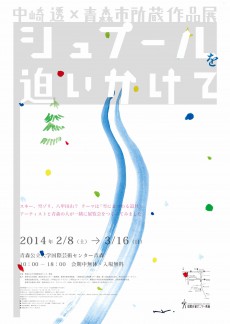
NAKAZAKI Tohru ×Aomori City Archives Exhibition “Tracing snow tracks”
Aomori’s status as one of Japan’s snowiest cities has naturally led its residents to come up with various methods of coping with the harsh winters which come every year.
One example of this is skiing. When skiing was first introduced to Japan, it was not seen as just a sport, but rather a tool which could aid people’s lives and work; an attitude that has given birth to many Japanese professional skiers over the years. Under the direction of artist NAKAZAKI Tohru, we have been holding workshops at the Aomori Contemporary Art Centre, Aomori Public University (ACAC) over the past year with the goal of creating an “Aomori City Archives Exhibition”. However, the exhibition shall not be restricted exclusively to items from within AomoriCity itself.
We plan on displaying a whole host of objects ranging from ski gear used by Aomori native skiers such as Yūichirō Miura, photo/video of people with strong ties to Mt.Hakkōda and woodblock prints/paintings which depict Aomori winters. These items were donated by corporations, groups and individuals based in AomoriPrefecture. Additionally, there shall be several other items on display, including over 100 pairs of skis dating from the early Shōwa period to the present day.
Thanks to the efforts of Tohru Nakazaki and all those who participated in our workshops, we are confident that this exhibition shall reveal a previously unheard tale of Aomori’s history, people and culture.
———
Hello, my name is NAKAZAKI Tohru. After being invited to hold an exhibition here in Aomori; I came to do some preliminary research in March 2013. I remember being impressed by the ski gear that I saw in the AomoriCityForestryMuseum and thinking that I’d like to do an exhibition based on the, admittedly somewhat vague, theme of “Snow-related gear”.
All those involved, including myself, had no prior experience of holding an exhibition, however, things ultimately fell into place as we received fascinating objects and stories from the people we met through our various workshops.
Due to the fact that our exhibition covers such a broad range of topics, I’m sure that specialists in various fields may feel that there are areas we skimmed over or forgot to include; but I’m confident that our collective team effort has given the exhibition its own unique personality. We worked hard to trace the history of how people have dealt with Aomori’s snow over the years and if you’re able to experience that, then I feel we’ve done our job.
NAKAZAKI Tohru (Artist)
———
Exhibition view
photo: NISHIKAWA Koji
—
[Essay]
Living the Present Progressive
KANEKO Yukiko
“In fact, the written word is all in past tense. Conversely, even if words we speak are about the past, they are still in present tense. This means that whatever we are conscious of at the moment is the present and that emotion is only possible in the present tense…One’s past experiences always possess the possibility of returning to the present.”
SUGA Keijiro[i]
Winters in Aomori City blanket everything with snow. It becomes almost impossible to even leave home if you without shoveling. Roads shrink to half their width, public transportation is delayed, and rubber boots are the only footwear that will do the job. The sun sets around 4 p.m. and there are often times when blizzards make it impossible to move forwards or backwards. These are just a few examples that may give rise to the basic question of why anyone on earth would ever choose to start living here, a land where this bitter, cold season has an icy grip over a third of the year. But the people here have continued to live with a wisdom and device unique to the region in order to keep out the cold, move about freely in the snow, and ultimately make winter as comfortable as humanly possible.
Around 20 participants of all ages and professions joined “It’s Exhibition Making Time!” NAKAZAKI Tohru’s workshop that began in May 2013. Among them were those who had never been to the Aomori Contemporary Art Center (ACAC), so activities began by getting to know the ACAC. Following this, participants worked together with Nakazaki touring facilities, organizing talk events, and conducting inquiries into the items exhibited.
Nakazaki had visited individuals connected with Aomori’s skiing heritage to hear their stories since his research began in March. But in July and beyond, even as workshop activities began in earnest, he and the workshop participants continued to consciously create opportunities for interviews, even those that would not be included in the catalogue or exhibition. At the start of these interviews, neither Nakazaki nor the participants had any intention of displaying the interviewees’ exact words in the exhibition. What begun as part of the very basic investigations to gain reference material in preparation for the exhibition had by the end constituted an integral element of the exhibition itself, the words chosen from individual interviews by Nakazaki connecting beautifully with the works on display.
Originally carried out to better understand past events and particular events like the Olympics and professions such as mountain guides, the interviews became fascinating experiences within themselves. They added a certain vividness inaccessible through books alone. They provided the character and personality of the speaker; identified the speaker’s relationships with objects, other people, and surrounding events; and recreated a sense of presence, of actually being there at the scene. We now heard intimate stories of individuals who lived in the same regions as figures such as MIURA Yuichiro and MUNAKATA Shiko, whom we had only ever known through books and film, and saw before us Mt. Hakkoda, a mountain many of us had only ever gazed upon from its base. We caught sight of a world that was no longer the fairy tale of others but one with a past and present of which we too were a part.
Japanese thinker and psychologist KIMURA Bin categorizes what we consider “reality” into two types: reality and actuality. Reality is objective, third person, and takes form in the instant after the present—it is the present perfect. Actuality, on the other hand, is subjective, first person, and constantly changing in the present progressive—the scene of the action. He also states that the ultimate mission of rational science is to understand reality.[ii]
Exhibitions that display folk heritage value reality and are essentially built on rational science. However, Nakazaki added interview quotes as descriptions of the exhibited items not to show the stringency of some objective reality, but to stress the importance of a personally embellished actuality. From them, he indicated the importance of grasping how a particular individual connects with other persons, objects, and events. This in itself is a domain of art: how each of us sees the world through our own unique points of view, takes courage in our relationships, and affirms the distorted narratives we design for ourselves based on the above.
This project was planned as an educational program offered in the form of an Artist In Residence (AIR). Peace education utilizes exposure[iii]—putting oneself at the scene of whatever is happening—and having witnessed many different scenes over the past year, we have come to understand events that have occurred and the existences of people who have lived here and still live here today. This leads to the realization that our current selves are also invisibly connected to them. By providing a space where something is constantly happening, the ACAC, as a residence facility for contemporary art, can offer up the realization of living in such fluid times, in the here and now, and create opportunities for individuals to acquire the skills and techniques to survive within them, which continues until death. This means inquiring about reality in the field and trusting individual actualities. In other words, this seems to support seeing with one’s own eyes and thinking critically.
How can we as residents of Aomori come to know the place where we presently live, whether or not we have been born and raised here or have ended up here due to work, study, or some other twist of fate? Can we find joys and pleasures within our daily routine and cherish each day? Instead of grumbling about shoveling snow each morning, take a step outside of your daily grind. There are people who have launched into the world of winter sports, their bodies disciplined in Aomori’s environment. There are individuals who have made the mountains their profession, having fallen in love with the mountains and skiing. There are those who possess knowledge and techniques that verge on superhuman. And there is Mt. Hakkoda, a mountain laden with episodes of their histories.
This yearlong encounter with people and narratives has transformed the existence of snow as nuisance into a medium that generates fascinating stories. An outline emerges of the here and now in which I exist, having collected and created many actualities by giving myself to the scene and encountering other individuals face to face. This gives us the confidence that we have the potential to connect with any worlds we desire. And I dream that this leads to the confidence to keep on living.
Translated by Alex QUEEN
[i]TAKAYAMA Akira × SUGA Keijiro (2013). “Tokyo heterotopia no tabi: zure no honyakuron, kako kara kaette kuru genzai” [A Journey into Tokyo Heterotopia: Translation Theory of Deviation and the Return to the Present from the Past]. Tokyo Heterotopia Festival. Tokyo Executive Committee: 4.
[ii]Adapted from KIMURA Bin (2005). Kankei toshite no jiko [The self as relation]. Misuzu Shobo: 56-57. KIMURA states, “Reality always contains ingredients of actuality, and actuality can only be formed on the basis of reality” (p. 57).
[iii] “Exposure its taken in its literal meaning: exposing the body to wind or light…Here it refers to a type of journey in which an individual touches the raw situation of others in other places with their whole mind and body.” YOKOYAMA Masaki (1993). “Daisan-sekai to senshin-kogyoushokokuniwatarushiminrentaiwakanou ka” [Is Civil Solidarity Between the Third World and Advanced Industrialized Countries?]. Shiminrentai-rontoshite no daisan-sekai [The Third World as a Theory of Civil Solidarity]. Ed. KUBOTA Jun. Bunshindo: 47.
—
Play and Diversion―the exhibition ofthe city collection and NAKAZAKITohru’s work
KONDO Yuki
Works by Nakazaki are based on the so-called “relational aesthetics”[1], in which the relationship and/or involvement with external factors are essential in the creation of artworks. It means that others’ participation in the production is necessary. In his participatory pieces, though communication is referred to, discrepancies in their dialogues are often incorporated exquisitely. An end product and a physical form of his early work signmaker NAKAZAKI(fig.1), for example, isthe signboardmade after he received a request to produce it. Before the production, there is a temporary “agreement” made for communication on the assumption that there would be miscommunication,and a difference in interpretations between the sender and the recipient of the message is intentionally made.While involving the viewer and collaborators, hiswork seems to bekeeping somewhat low temperature. It is probably because he is not only paying attention to differences in dialogues but also regards differences as a structure, not a phenomenon.
As in “build-to-order manufacturing,” a temporary setup or purpose is often presented as a premise in his work. Through a simulative approach of role-playing, the process to reach the goal and derivative happenings are pseudo indicated, so that the substructure of art or society is revealed like an overturned iceberg. The same applies toprojects conducted by his artist unit, “Nadegata Instant Party.” (Nadegata means low shoulders.) Their way of copying and reproducing real acts and phenomena through simulated experiences is theatrical. In the Nadegata projects, they play roles in the process ofconducting the projects, and in the Nadegata “exhibition,” in which fictitious elements become fixed images through data media, vicarious experiences are possible based on the directional time axis of the past just like you watch a documentary film or a motion picture. As for Nakazaki’s work, on the other hand, the viewer experiences his work on the same time axis as watching it on stage. For this experientially oriented appreciation of the work, texts and situation-related contexts are often used.In Guess someone after one hundred thousand years would watch out for a playboy carefully (2011, fig.2) and How We Behave Ourselves Today (2013, fig.3), daily necessities displayed in different contexts as well as arbitrary texts of rearranged excerpts from weekly magazines are combined with the situation, which is (or appears to be) given a symbolic meaning like a stage setting.Although there is no denying that the artist’s intention guides viewers to some extent, they can appreciate the work personally and directly. They experience it physically, sensuously and actively in the installation prepared as a stage setting, which is so neutral and open that they could read between the lines freely thinking about the possible or probable background for two or more stories.
A tentative purposefor him this time isto “produce the exhibition of the city collection.”It is the precondition, but Nakazaki is neither a folklorist nor historian. While adopting the disguise of a “technical style,” he carried on the work consciously taking advantage of the fact that he is not an expert. His earnestly working “non-specialist” planning team admits their lack of accuracy at the very end, and tries to keep a distance from confirmation and judgment of historical facts. The exhibition focusing on interviews with related people places more emphasis on interviewees’ personal memories and perceptions than the accuracy of historical facts. As conveying the feeling and atmosphere of each interview is important, they are presented as they are without brushing up the wording or converting local Tsugaru dialect into standard Japanese. We find a lot of noise in there, contrary to the scrutinized informationfor accurate communication. This uncertainty, however, helps avoid one-sided transmission/ reception of messages and leaves room for us to intervene comfortably. Subjective speeches coming from collected memories of individuals and the exhibits that look like a stage setting are regarded as innumerable conversation pieces,which bring out recollections, memories and personal views of people who come into contact with the exhibited pieces. Both workshops of “the exhibition of the city collection” and the exhibition itself are produced as the site for dialogue where many people can be connected.
Viewing this exhibition from the angle described above, you will understand that it is intended not only to look through the cultural history of tools used for snow in Aomori and other things to uncover the buried history, but alsoto let them whisper here and there by including many ambiguous memories and stories as they are and putting fragments from various erasside by side. The exhibit revealsan overall history of the subjective memories. There is the artist’s attachment to the city collection as remains of the history of local city Aomori as well as his doubt about historical objectivity.
His attitude not to set the direction for people’s memories and consciousness is related to the structure in which he often confronts,through his work, communications suspended in midair or our “inability to communicate with each other.”Parallel / DakaratokaKosodatoka(2011, fig.4) produced after the great earthquake shows how he structured the work comparing parallel lines to disparities in real disastersamong different districts and the inability to understand each other. It emphasizes the feelings of an “individual,” and also indicates the reality of our days that it is no longer possible for us to go along with the single big tide together. Such a structure is immanent in the exhibition of the city collection held this time, and I would say that this event goes beyond a mere exhibit of materials,and can be regarded as Nakazaki’s work.
Translated by NISHIZAWA Miki
[1]Nicolas BOURRIAUD, Esthetiquerelationnelle, Les Presses du reel, 1998.
fig.1 signmaker NAKAZAKI, 2008
fig.2 Guess someone after one hundred thousandyears would watcu out for a playboy carefully, 2011
fig.3 , How We Behave Ourselves Today, 2013
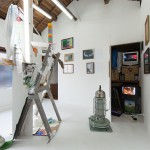
fig.4 Parallel/ Dakaratoka Kosodatoka, Art Centrer Ongoing, 2011
- 日時
- February 8 (sat)- March 16 (sun), 2014
- 会場
- garelly A
- 対象
- admission free


